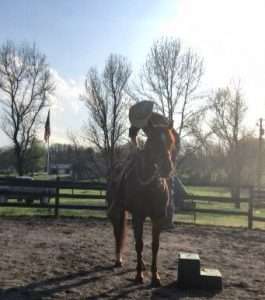From the Block to the Saddle

Moving Cattle- An Art and a Science
March 11, 2021
Round Pen and Arena Construction
March 12, 2021“You have to crawl before you can walk” is a phrase we all have heard before. In essence, there is a lesson that must be understood prior to even taking the first step. In the world of horses, the phrase should be “You have to mount before you can walk”.
Mounting a horse is something we all take for granted, but in our time training horses and riding for the brands, it is one of the most overlooked factors of riding there is! Go to any show or public arena and just observe, you will quickly realize how many folks go to mount their horse and the horse takes a step or will not get up to the block, or one the rider gets a leg over the horse starts to move and wont sit still. This is an easy to address problem that takes time and patience, and is much more common than any of us care to admit.
The issue begins at a deeper root than just mounting though, a lot of the time the issue is the horse’s attention span and patience level. Developing a solid mount and taking the time to refine patience will benefit your horse in numerous ways: quietness while tied, ease of tacking, quietness on trails, faster recovery after action versus being “hot”. All of these can benefit from working on the mount.

Here at Shadow Hills Ranch, we believe that any and all issues, lessons, and maneuvers start on the ground. Mounting is no different. The most well trained horse on the planet can always benefit from going back to the basics!
So, how does ground work help teach a horse patience? It is a simple concept really- we ask our horses to move all the time but rarely ask to stop. By implementing a break in the action while doing groundwork, we are making that connection within the horse’s mind that it is okay to not always be moving. Lets take a basic circle with a change of direction for example.
When we start with the basic circle, we send our horse out around us after orienting the horse to the environment. We ask for two things to be constant: speed and direction. After doing a few circles, we change direction and repeat. In that change of direction there is a great opportunity to practice a full stop, using either verbal or physical cues. Once the stop is obtained, another opportunity presents itself and that is to reinforce a stand-still by taking the time to essentially mess with the horse- petting, patting, lifting feet, swinging the lead, jumping, walking, running, anything and everything around the horse. We are teaching the horse that being still is not a bad thing. After we are done, we send the horse back out around us and repeat the stop (if asked) or go for a more continuous change of direction.
It is crucial that we establish a solid “stop” cue, preferably verbal and physical, with our horses. When we ask for a stop, it means STOP. Not slow down, not drag our feet then stop, it means hit the brakes and do not move. The cues I use is “Whoa” and slight pressure on the rope. That hits both categories: verbal and physical. Practicing this technique correctly will give you a solid and unquestionable stop.
Once this no-questions-asked stop is reinforced, we have something to build off of. We can start to mold on the ground etiquette during saddling, we can progress into ground tying, we can practice mounting and dismounting and set our horses up for success. Since this is about the mount, we are only going to address the mount.
We have established a stop and are going to practice mounting. We go to mount and sit in the saddle for a moment to watch for movement. If there is no movement we proceed to get into the stirrups and wait again for movement. If there still is no movement and we are ready to proceed, we give the cue to move, whatever it may be. If the horse moves at any moment, we correct and wait for the appropriate response. Correcting can be as easy as giving the verbal and physical cue. Once the desired response is given, we start from square 1: we dismount and start over. This process is repeated until we can go through the full mounting routine without movement. We reward good behavior, and we proceed with the ride. Here at Shadow Hills Ranch, we mount and dismount every horse numerous times during the training day to continue to reinforce the “stop means stop” behavior. On top of this, we will constantly mount and dismount in more than one environment. I want every horse that comes through the gates to be able to be mounted/dismounted calmly and patiently no matter the surroundings or situation. If we are checking fences, I repeat the routine often. If I am working on a performance horse learning to spin, I will still mount/dismount when given the chance. Again, this reinforcement makes understanding, and a solid stop/still makes many more tasks easier when we get to them.
The moral of the story is that “stop” means “stop”, no matter the surroundings and no matter the situation! Work with your horse on this very thing, and you will see a difference in multiple riding factors.





